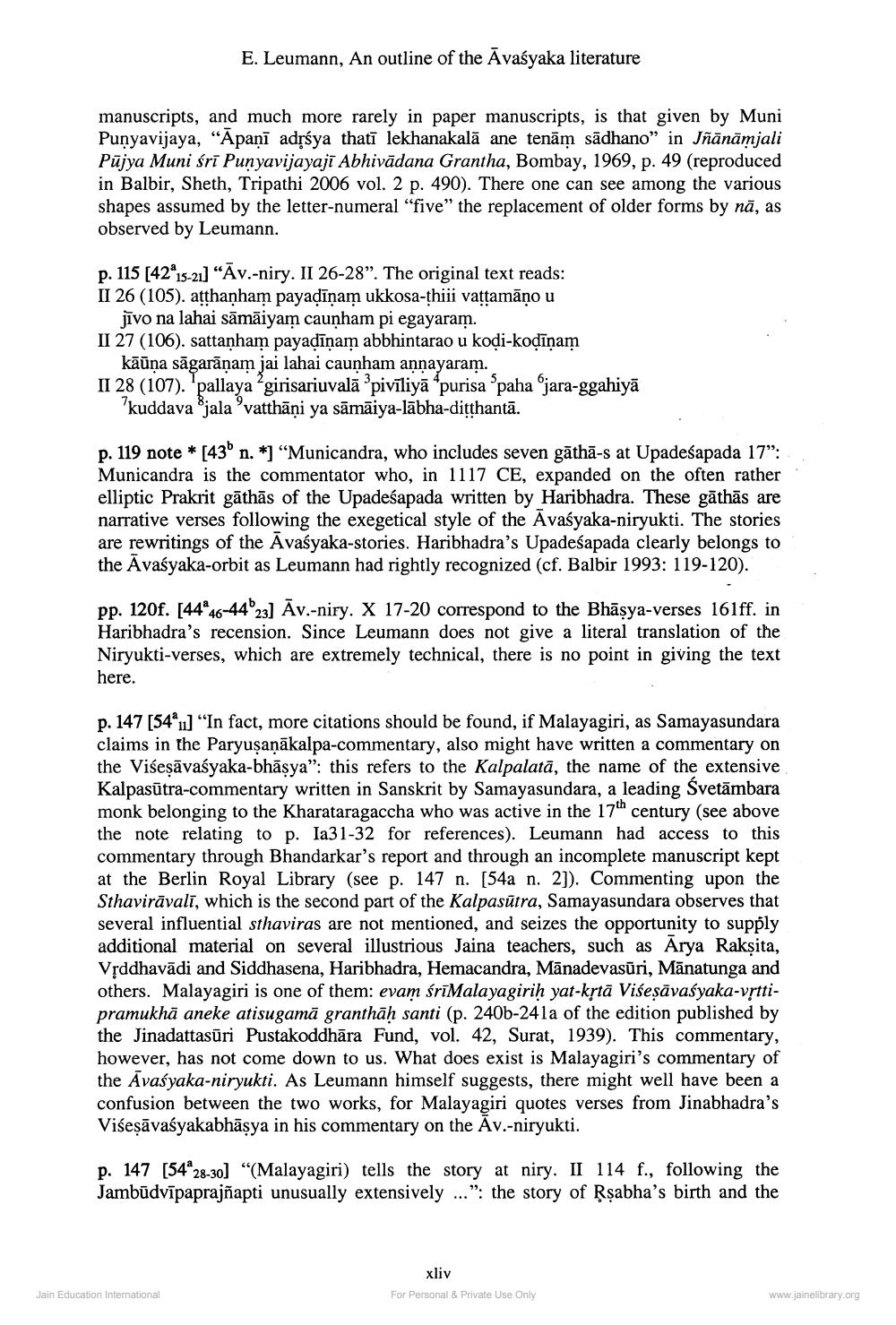________________
E. Leumann, An outline of the Āvaśyaka literature
manuscripts, and much more rarely in paper manuscripts, is that given by Muni Punyavijaya, "Apaņī adrśya thati lekhanakalā ane tenām sādhano" in Jñānāmjali Pujya Muni śrī Punyavijayaji Abhivādana Grantha, Bombay, 1969, p. 49 (reproduced in Balbir, Sheth, Tripathi 2006 vol. 2 p. 490). There one can see among the various shapes assumed by the letter-numeral “five" the replacement of older forms by nā, as observed by Leumann.
p. 115 [42°15-21] “Av.-niry. II 26-28”. The original text reads: II 26 (105). atthanham payaļīņam ukkosa-thiii vattamāņo u
jīvo na lahai sāmāiyam caunham pi egayaram. II 27 (106). sattanham payadīņam abbhintarao u kodi-kodīņam
kāūņa sāgarāņam jai lahai caunham annayaram. II 28 (107). "pallaya girisariuvalā ?pivīliyā “purisa 'paha “jara-ggahiyā
'kuddava ojala 'vatthāņi ya sāmāiya-lābha-ditthantā.
p. 119 note * [430 n. *] "Municandra, who includes seven gāthā-s at Upadeśapada 17": Municandra is the commentator who, in 1117 CE, expanded on the often rather elliptic Prakrit gāthās of the Upadeśapada written by Haribhadra. These gāthās are narrative verses following the exegetical style of the Avaśyaka-niryukti. The stories are rewritings of the Avaśyaka-stories. Haribhadra's Upadeśapada clearly belongs to the Avaśyaka-orbit as Leumann had rightly recognized (cf. Balbir 1993: 119-120).
pp. 120f. [44 46-4423] Āv.-niry. X 17-20 correspond to the Bhāşya-verses 161ff. in Haribhadra's recension. Since Leumann does not give a literal translation of the Niryukti-verses, which are extremely technical, there is no point in giving the text here.
p. 147 [54°11] “In fact, more citations should be found, if Malayagiri, as Samayasundara claims in the Paryusaņākalpa-commentary, also might have written a commentary on the Višeşāvasyaka-bhāsya": this refers to the Kalpalatā, the name of the extensive Kalpasūtra-commentary written in Sanskrit by Samayasundara, a leading Svetāmbara monk belonging to the Kharataragaccha who was active in the 17th century (see above the note relating to p. la31-32 for references). Leumann had access to this commentary through Bhandarkar's report and through an incomplete manuscript kept at the Berlin Royal Library (see p. 147 n. [54a n. 2]). Commenting upon the Sthavirāvalī, which is the second part of the Kalpasūtra, Samayasundara observes that several influential sthaviras are not mentioned, and seizes the opportunity to supply additional material on several illustrious Jaina teachers, such as Arya Raksita, Vrddhavādi and Siddhasena, Haribhadra, Hemacandra, Mānadevasūri, Mānatunga and others. Malayagiri is one of them: evam śrīMalayagirih yat-kstā Višeşāvasyaka-vrttipramukhā aneke atisugamā granthāh santi (p. 240b-241a of the edition published by the Jinadattasūri Pustakoddhāra Fund, vol. 42, Surat, 1939). This commentary, however, has not come down to us. What does exist is Malayagiri's commentary of the Avasyaka-niryukti. As Leumann himself suggests, there might well have been a confusion between the two works, for Malayagiri quotes verses from Jinabhadra's Višeşāvaśyakabhāsya in his commentary on the Av.-niryukti.
p. 147 [54°28-30] "(Malayagiri) tells the story at niry. II 114 f., following the Jambūdvīpaprajñapti unusually extensively ...”: the story of Rşabha's birth and the
xliv For Personal & Private Use Only
Jain Education International
www.jainelibrary.org




